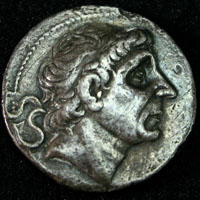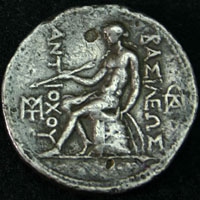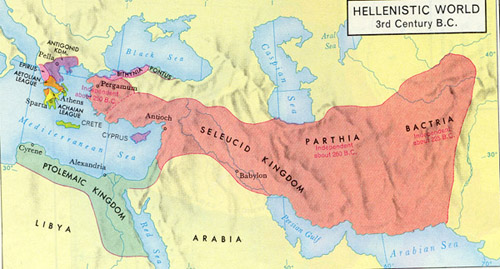Silver Tetradrachm, Seleucia-on-the-Tigris mint
weight: 16.1g; width: 2.92cm; die axis: 1h


OBV.: : Diademed head of Antiochus I Soter (281-261 BCE) right, set in dotted border.
REV.: Naked Apollo sitting on the Delphic Omphalos, looking left down on an arrow, in dotted border. Apollo’s bow is leaning against the right side of the omphalos. Inscription left: "ANTIXOY" (= Antiochou, "of Antiochos"), right: "BASILEWS" (= Basileos, "of the king"). Control-marks: monogram left: MAT, monogram right: APO (?).
HFMA nr. 2006.010.002. Ref.: SNG Spaer 385 (= Newell, ESM 180) and Spaer 386 (both with same control-marks); cf. Houghton, CSE 955 (only MAT mark).
When Antiochus II (261-246 BCE) succeeded his father Antiochus I as king, the Seleucids had just suffered a defeat against Eumenes near Sardes (262 BCE). This defeat resulted in the loss of Pergamum, which became an independent kingdom that over the next one hundred years continued to grow at the expense of the Seleucids. Moreover, Ptolemy II Philadelphos of Egypt used the momentary weakness of his Seleucid rival to attack him in Asia Minor and Syria (Second Syrian War, 260-253 BCE).
Not surprisingly, the early coinage of Antiochus II promotes the idea of stable Seleucid rule by continuing the coin designs of his father, the late Antiochus I. The obverse shows Antiochus I as an older man with deep-set eyes and sharply-defined features and thus reflects his age (he was 48) when he defeated Celtic invaders, the Galatai, in 276 BCE, a victory that earned him the title Soter or Savior.
The reverse design, also introduced by Antiochus I, became the most common Seleucid reverse type. It shows the god Apollo sitting on the Delphic Omphalos with his attributes, bow and arrow. The Omphalos or "navel" was a sacred stone in Apollo's temple precinct in Delphi that the Greeks believed marked the center of the world. Its special status is marked by the tainiai or ribbons that criss-cross its surface.
Antiochus I had made Apollo the patron god of the Seleucids and built him a temple in Daphne near the Seleucid capital, Antioch-on-the-Orontes. On this posthumous coinage, the image of Apollo could also serve as a reminder that Antiochus II had declared his late father a god under the name Antiochus Apollo Soter (CIG 4458).
O.K.


